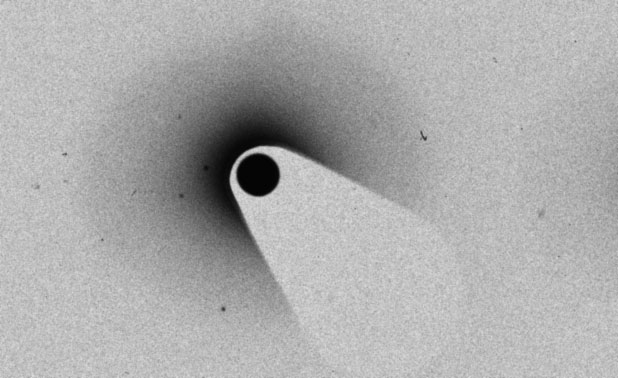Using observatiions recorded on photographic plates by Dan Pascu during the second half of the XXth century, an international team has shown that the ground based information about the positions of Martian satellites could be just as good as that obtained for the same period by satellites.

The difficulty of obtaining data on Martian satellites
Even today, it is hard to obtain data from the ground on the two Martian satellites Phobos et Deimos. They are hard to observe, since their apparent magnitude is poor, and their orbits are very close to the bright red planet.
Nevertheless, and in spite of in-situ space probes, it is vital to do this, in order to determine their motions both in the past and in the future. This allows one to distinguish between the various diffferent models for the formation and evolution of this system.
Furthermore, Martian tidal effects are directly responsible for the orbital acceleration of Phobos. The possibility of analyzing the motions of the two satellites over extended periods of time enables one to better understand the internal structure of the planet.
In 1971, in order to overcome in particular the problems related to the differences in brightness, Dan Pascu, an American astronomer at the U.S. Naval O bservatory, developed an original method. He used a very long focal length astronomical refractor, together with a NiChrome (an alloy of Nickel and Chromium) filter.
A set of photographic plates of the Martain satellites was obtained in this way.
While these observations have become a world standard in terms of ground based astrometric accurccy, they are nevertheless of limited use, since on each plate are stars which were not catalogued at that time.
Consequently, these stars cannot be used as reference stars, and so the position of Mars on the celestial sphere cannot be determined, reducing the accuracy with which the positions of the satellites with respect to the planet to several tens of kilometres.
Moreover, each plate was analyzed visullay.
Forty years later, automatization has replaced the human eye, so that the positions of the stars are now known to a suffficient accuracy.
A vast project for the digitization of the photographic plates
Photographic platesconstitute nevertheless an analogue system, inadequate for direct digital use.
This is the motivation for the project to digitize the photographic plates by the European consortium ESPaCE.
The plates obtained at USNO by Dan Pascu are being digitized with the help of a new generation canner at the Belgian Royal Observatory.
A specific procedure is being developed to identify various celestial objects, to measure and to correct the measurements of their positions, and finally to extract from this material astrometric data of unequalled quality.
The accuracy of the positions of the planet and its satellites using these observations has now reached 20 km, which is quite comparable to that obtained in the 1970s by space probles in orbit around Mars.
In effect, the end of 1971 corresponds to the arrival of the Mariner 9 space probe at Mars, and the start of the Viking program. Their positional accuracy is better than 25 km.
The dawn of the first « Gaia » catalogue
These innovative results have quite unexpectedly open ed the road to all kinds of photographic observations involving the dynamics of solar system bodies
They lead to a re-analysis of old observations, expecially as the European satellite Gaia should produce, starting 2016, a preliminary catalogue of stars to a precision at least one hundred time better than existing catalogues.
In the long term, all the bodies of the solar system will be concerned.
The international team
The international team is made up of scientists :
- from the Paris Observatory at the’IMCCE (Paris Observatory/CNRS/UPMC/Lille 1 University),
- the Polytechnic Institute for Advanced Scienc e (Institut Polytechnique des Sciences Avancées - IPSA),
- The United States Naval Observatory (USNO),
- the Berlin Technical Institute (TUB)
- and the Belgian Royal Observatory (ORB),
Reference
This work has been published in Astronomy and Astrophysics.
A new astrometric measurement and reduction of USNO photographic observations of Phobos and Deimos : 1967-1997, V. Robert, V. Lainey, D. Pascu, A. Pasewaldt, J.-E. Arlot, J.-P. de Cuyper, V. Dehant, W. Thuillot, A&A 582, octobre 2015.
Collaboration
This result was obtained by an international team within the framework of the FP7-ESPACE program, financed by the European Community’s Seventh Framework Program (FP7/2007-2013) n°263466.
